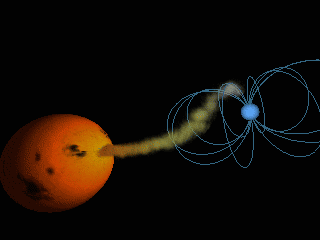
Long Term Polar Monitoring Programme

RXJ1712. Courtesy Dr. Andrew Beardmore, University of Leicester
The BAAVSS Long Term Polar Monitoring Programme has been set up to monitor over a period of years a selection of AM Her stars (see list below), which are in need of further investigation. The objective is to observe on a nightly basis both visually and with CCD's, and to report any change in high/low state activity. The programme is supported by Dr Boris Gaensicke, Warwick University, whose article on Polars appeared in the September 2006 issue of the BAAVSS Circular (No. 129), and was the catalyst for this programme to be launched. You can read the article here.
A report from the first five years of the programme (2006-2011) was published in the Journal of the BAA Vol 123, 2, 2013 and can be seen here.
Charts with high quality sequences already exist for some of these stars, but several do not yet have a good sequence. Preliminary charts and sequences have therefore been prepared so that observing can begin. Hopefully better sequences will come along in the not so distant future.
The chart column gives a link to either the preliminary chart (P), or if an 'A' is shown, the link takes you to the AAVSO web page where the chart can be downloaded. An 'H' indicates the sequence is a Henden/Simonsen chart. A 'B' takes you to a BAAVSS chart. An '*' indicates that a chart is not yet available. Preliminary charts are approx. 25' field.
Observations should be reported to the BAAVSS in the usual way. However if a change in state is observed, then please send an e-mail to the programme co-ordinator (Gary Poyner) as soon as possible.
Star |
RA(2000) |
Dec (2000) |
Mag. Max |
Mag. Min. |
Porb. (d) |
Chart |
|
|
|
|
|
|
|
01 55 43.44 |
+00 28 06.4 |
14.7p |
17.6p |
0.060516 |
||
02 03 48.60 |
+29 59 26.0 |
15.5V |
18.0V |
0.191745 |
||
05 15 41.41 |
+01 04 40.4 |
15.2V |
17.3V |
0.332612 |
||
05 42 48.77 |
+60 51 31.5 |
14.6V |
17.5V |
0.139753 |
||
| FR Lyn (EUVE J0854+390) | 08 54 14.2 | +39 05 40 | 15.5C | <17.0C | 0.078681 | B |
GG Leo |
10 15 34.67 |
+09 04 42.0 |
16.5V |
18.8V |
0.055471 |
|
| WX LMi | 10 26 27.5 | +38 45 01 | ? | 17.5 | 0.116389 | P |
AN UMa |
11 04 25.67 |
+45 03 14.0 |
13.8B |
20.2B |
0.079753 |
|
11 05 39.76 |
+26 06 28.7 |
15.0V |
17.2V |
0.079753 |
||
AR UMa |
11 15 44.56 |
+42 58 22.4 |
13.3V |
16.5V |
0.080501 |
|
DP Leo |
11 17 15.93 |
+17 57 42.0 |
17.5B |
19.5B |
0.062363 |
|
11 49 55.71 |
+28 45 07.6 |
16.5B |
? |
0.062600 |
||
15 52 47.18 |
+18 56 29.2 |
14.9V |
17.0V |
0.078798 |
||
15 54 12.34 |
+27 21 52.4 |
16.8B |
- |
0.105462 |
||
16 10 07.51 |
+03 52 33.0 |
15.9V |
- |
0.132200 |
||
18 00 35.58 |
+08 10 13.6 |
16.1V |
21.0V |
0.078450 |
||
18 02 06.52 |
+18 04 44.9 |
14.5V |
? |
0.078480 |
||
20 05 41.91 |
22 39 58.9 |
14.5B |
15.5B |
0.15452 |
Notes from Dr. Gaensicke: AI Tri and V1309 Ori are two very long period Polars. BY Cam contains a slightly asynchronously rotating white dwarf. AR UMa, AP CrB and V884 Her are Polars with very high magnetic fields. FL Cet (SDSS015543) is deeply eclipsing. WX LMi is a very low accretion Polar - possibly a pre-Polar (detached system) with accretion from the wind rather than mass transfer from secondary. Monitor for a rise to high state.
It is unlikely that any of the stars listed above will be removed from the programme, but others may well be added from time to time. Please check these web pages regularly for programme updates.
See also the HQSCV web page, maintained by Dr. Boris Gaensicke, for more information on some of the stars given in the above table.
BAA Variable Star Section:
Director: Mr. Roger Pickard
Last update 19/03/10